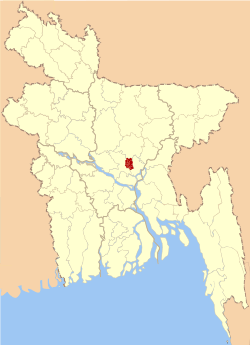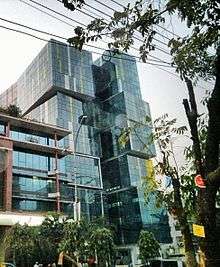Economy of Dhaka
 The location of Dhaka on the map of Bangladesh | |
| Statistics | |
|---|---|
| GDP | $95.76 billion (nominal)[1] |
GDP per capita | $4,822 (2013)[2] |
Population below poverty line | 16% |
| Unemployment | 19% (2013)[3] |
| Public finances | |
| Expenses | $490 million (DSCC + DNCC)[4] |
Dhaka is the commercial centre of Bangladesh. According to Cambridge University's 2014 analysis, the total nominal Gross State Product (GDP) of Dhaka was US$37 billion,[1] accounting for 35% of Bangladesh's economy. Dhaka is also home to major Bangladeshi industrial conglomerates such as Beximco Holdings Limited, Bashundhara Group, Jamuna Group, PRAN-RFL Group, BSRM and Defense Advancement Trading Company (DATCO).[5] Many foreign establishment such as GlaxoSmithKline, Heidelberg Cement, Reckitt Benckiser, HSBC, British American Tobacco, and Nestlé have their regional headquarters located in Dhaka.[6]
During the Mughal Era and Bengal Presidency, Dhaka was the largest economy within the Bengal and Sub-continent region. With a GSP of US$227 billion, Dhaka has the biggest economy among the divisions in Bangladesh.[7] If Dhaka were a nation, it would rank as the 58th largest economy in the world, ahead of neighbouring countries like Sri Lanka, Myanmar, and Nepal. Its 2013 per capita personal income was US$4,822 an increase of approximately 6.0% from 2013, placing it second only behind port city Chittagong.[8]
History
Due to its location right beside some main river routes, Dhaka was an important centre for business. Muslin fabric was produced and traded in this area.[9]
Italian traveller Niccolao Manucci came to Dhaka in 1662–63. According to him, there were only two kuthis (trading posts) – one of the English and the other of the Dutch. Ships were loaded with fine white cotton and silk fabrics.[10]

Sectors
| Top publicly traded companies in Dhaka for 2015 |
| Beximco |
| One Bank Limited |
| Al-Arafah Islami Bank Limited |
| Prime Bank Limited |
| United Airways |
| Mercantile Bank Limited |
| Beximco Pharma |
| Summit Power Limited |
The manufacture of brick in Dhaka's suburbs, which adds little to gross national product, adds significantly to PM2.5 air pollution.[11]
International trade and other sectors
Dhaka has historically derived significant revenue from International trade, Textile, Pharmachemical and financial institutions. The exports of goods made in Dhaka totalled approximately US$10 billion in 2012, with a rapid growth in Pharmachemical, and IT with 15.68% and 7.28% growth.
See also
References
- 1 2 Cambridge Centre for Risk Studies at the University of Cambridge Judge Business School. "Dhaka Factsheet". Lloyd's City Risk Index 2015–2025. Lloy'ds. Retrieved 25 November 2016.
- ↑ "Dhaka – World's Largest Metropolitan Cities". Retrieved 29 October 2014.
- ↑ "Asian Metropolis: Dhaka" (PDF). Urban. Retrieved 29 October 2014.
- ↑ Mollah, Shahjahan (6 July 2014). "Budget for split DCCs Monday, Tuesday". Banglanews24.com. Archived from the original on 10 July 2017. Retrieved 18 February 2015.
For the fiscal year 2014-15, the DSCC budget will stand at Tk 1,800 crore while Dhaka North City Corporation would be announced its budget of Tk 2,000 crore.
- ↑ "Dhaka Improving Living Conditions of the Poor". Retrieved 29 October 2014.
- ↑ "Top 10 Multinational Companies in Bangladesh". www.businesshabit.com. Retrieved 30 December 2015.
- ↑ Kabir, Anisul; Parolin, Bruno. "PLANNING AND DEVELOPMENT OF DHAKA – A STORY OF 400 YEARS" (PDF). fau.usp.br. Retrieved 30 December 2015.
- ↑ "Dhaka holds opportunity for many" (PDF). World Bank.
- ↑ Akter, Sayeeda (3 March 2010). "Economic life carved in history". The Daily Star. Retrieved 30 December 2015.
- ↑ Aniruddha Ray. "Manucci, Niccolao". Banglapedia. Retrieved 29 May 2015.
- ↑ Sohara Mehroze Shachi (September 5, 2018). "Bangladesh's Air Pollution Problem Grows, Brick by Brick". Undark. Retrieved September 7, 2018.
The kiln operations alone — while representing just 1 percent of the country’s GDP — generate nearly 60 percent of the particulate pollution in Dhaka, according to Bangladesh’s Department of Environment (DOE).